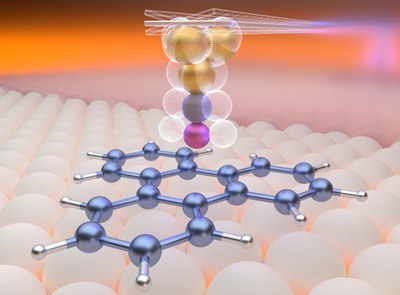A deep look into the molecule
New method for visualizing the chemical structure of single molecules - publication by physicists and chemists of the LOEWE focus group PriOSS
25. April 2022
To visualize the chemical structure of single molecules, scientists from the Justus Liebig University Giessen (JLU) and the University of Newcastle (UON) in Australia have published a new method in the journal "Nanoscale". The measurements require a low-temperature atomic force microscope (AFM) with an extremely sharp tip consisting of only a single CO (carbon monoxide) molecule, as well as tuning fork sensors (qPlus sensors), which can be excited to very small vibrations in the range of only a few picometers.
Usually, the tuning fork sensors are operated so that the CO tip oscillates perpendicular to the sample surface, similar to a diving board above the water surface. The scientists at JLU and UON have now succeeded in using a torsional oscillation mode (i.e., a twist along the longitudinal axis, see image) of the sensors for such high-resolution measurements of individual molecules. This causes the CO tip to oscillate approximately parallel to the surface. This provides an impressive image contrast based on lateral forces (forces acting from the side) with a particularly high distance dependence.
Until now, such measurements could only be performed with special lateral force sensors. The advantage of the new method is that by operating the sensor at a different resonance frequency, it is easy to switch between the conventional bond imaging method and the lateral force method. This eliminates the need to replace the entire sensor, which is time-consuming in case of low-temperature atomic force microscopes.
The work was founded, among others, by the Deutsche Forschungsgemeinschaft (DFG, German Research Foundation). In the future, the scientists would like to use the new technique to study molecular reaction processes on surfaces as part of the LOEWE focus group PriOSS (Principles of On-Surface Synthesis).
- Original Publication
Daniel Martin-Jimenez, Michael G. Ruppert, Alexander Ihle, Sebastian Ahles, Hermann A. Wegner, André Schirmeisen and Daniel Ebeling. "Chemical bond imaging using torsional and flexural higher eigenmodes of qPlus sensors." Nanoscale 14, 5329, 2022 (cover article)
https://doi.org/10.1039/D2NR01062C
- Contact
Dr. Daniel Ebeling
Institute for Applied Physics
Tel. 0641 99-33482
Presse, Kommunikation und Marketing • Justus-Liebig-Universität Gießen
